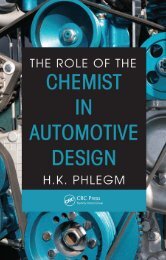Lightweight Electric/Hybrid Vehicle Design
Lightweight Electric/Hybrid Vehicle Design
Lightweight Electric/Hybrid Vehicle Design
Create successful ePaper yourself
Turn your PDF publications into a flip-book with our unique Google optimized e-Paper software.
50 <strong>Lightweight</strong> <strong>Electric</strong>/<strong>Hybrid</strong> <strong>Vehicle</strong> <strong>Design</strong><br />
2.5 Waste heat recovery, key element in supercar efficiency<br />
In the longer term vehicles will be electrically propelled using flywheel storage, hydrogen fuel<br />
cells or both. These systems potentially offer high cycle efficiencies, and low emissions vital to<br />
improving air quality in our big cities 11 .<br />
Bill Clinton’s initiative for US family cars to achieve 100 miles per gallon by 2003 is a<br />
serious challenge to the engineering industry; see Chapter 4. Current solutions include<br />
lightweight structures, reduced running losses and small engines. However, the author believes<br />
that the target can be achieved using conventional vehicle platforms with low drag floorpans<br />
and instead attention is focused on high efficiency drivetrains. Small engines give poor<br />
acceleration so to achieve acceptable performance hybrid technology is required. The internal<br />
combustion engine car achieves 28% efficiency under motorway conditions and half that on<br />
an urban cycle. The key problem is how to convert more of that energy into useful work. The<br />
account below will investigate two schemes: (a) turbine recovery system and (b) thermoelectric<br />
recovery system.<br />
In both schemes the energy produced is converted into electricity. This is because such an<br />
arrangement provides a plausible method for matching the power into the electrical drive. It is<br />
accepted that all mechanical solutions are also viable in a hybrid vehicle.<br />
2.5.1 HYBRID ELECTRIC DRIVE<br />
Figure 2.20 illustrates a parallel hybrid driveline using a Wankel engine and a brushless DC Motor.<br />
The package can produce 70 kW peak power and 20 kW average. This combination provides<br />
excellent acceleration using energy stored in a small flat plate lead-acid battery. Tests to date show<br />
this battery still delivers 100% peak power of 45 kW and 80% capacity after 22 000 cycles to 30%<br />
depth of discharge. Thermal management is vital to achieving these figures.<br />
The engine operates on a two stroke cycle and produces high quality waste heat at the exhaust.<br />
The temperature of the gas is around 1000°C. This gas contains 72% of the energy in the fuel. If<br />
we can convert a third of this energy into electricity we can nearly double the NTG of the vehicle<br />
under motorway conditions.<br />
Why is this important? <strong>Hybrid</strong> solutions are very effective at improving efficiency under urban<br />
cycle conditions but make no impact under motorway conditions. Here is a system that can begin<br />
to solve this problem. Supposing in the existing scheme we require 20 kW to operate a vehicle at<br />
MOTOR<br />
AND REDUCTION<br />
Fig. 2.20 Parallel hybrid drive Wankel<br />
engine and brushless DC motor.<br />
C<br />
B A<br />
ENGINE







